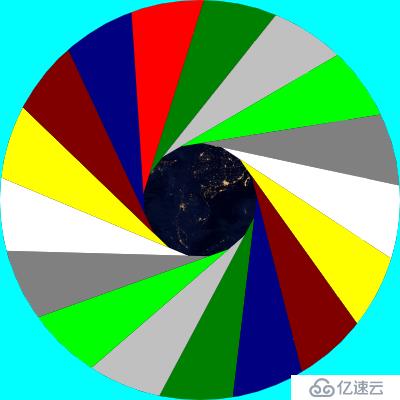公元前三世纪,欧几里得在《几何原本》中记载了正方形,正五边形,正六边形的做法,后来人们也掌握了正十五边形作图,但之后两千多年,人们没有在更高阶边形上取得突破。
1796年,19岁的高斯证明了正17边形可以由尺规作图作出,但没有给出具体做法;
1825年Johanes Erchinger发表了第一个正十七边形尺规作图法;
1898年,高斯的孙子发现了高斯在1796年3月30日关于正17边形作图的手稿,可以推断,高斯至少在当时在草稿纸上完成了作图分析过程。
我用canvas制作了正十七边形光阑,借此向伟大数学家高斯致敬。
光阑的效果图如下:




代码没有经过大改变,只是在 http://www.cnblogs.com/xiandedanteng/p/8735444.html 的基础上把angleCount改成了17,另外优化了getColor函数。
效果见下面五个图形,想看动画效果请自行下载代码然后用chrome浏览器打开。或者从 https://files.cnblogs.com/files/xiandedanteng/17%E5%85%89%E9%98%91.rar 下载录像观看。
代码下载地址:https://files.cnblogs.com/files/xiandedanteng/20180408_17guanglan.rar
Canvas代码是这样的:
<!DOCTYPE html>
<html lang="utf-8">
<meta http-equiv="Content-Type" content="text/html; charset=utf-8"/>
<head>
<title>17角光阑 2018年4月8日 向高斯致敬</title>
</head>
<body onload="draw()">
<canvas id="myCanvus" width="400px" height="400px" >
出现文字表示你的浏览器不支持HTML5
</canvas>
</body></html>
<script type="text/javascript">
<!--
function draw(){
var canvas=document.getElementById('myCanvus');
canvas.width=400;
canvas.height=400;
context=canvas.getContext('2d');
context.translate(200,200);
slot=new Slot();
animate();};
var delta=0; // 旋转角
var radius=0; // 旋转半径
var outerRad=200;// 外径
var context; // 绘画上下文
var slot; // 光阑对象
var angleCount=17;// 三角光阑为3,四角光阑为4,六角光阑为6
function animate(){
context.clearRect(-200,-200,400,400);// 清屏
slot.update(radius,delta,outerRad);
slot.paintBg(context);
slot.paint(context);
slot.paintBase(context);
delta+=0.5;
radius+=1;
if(radius<outerRad*0.9){
window.requestAnimationFrame(animate);// 让浏览器自行决定帧速率
}}
function Slot(){
var obj=new Object;
obj.ax=0;
obj.ay=0;
obj.bx=0;
obj.by=0;
obj.cx=0;
obj.cy=0;
obj.angleA=0;
obj.angleB=0;
obj.angleC=0;
obj.radius=0;
obj.outerRad=0;
obj.img=new Image();
obj.img.src="earth.jpg";
// 计算
obj.update=function(radius,theta,outerRad){
this.radius=radius;
this.outerRad=outerRad;
var alpha=Math.acos(radius/outerRad);
this.angleA=getRad(theta)+alpha;
this.ax=outerRad*Math.cos(this.angleA);
this.ay=outerRad*Math.sin(this.angleA);
var R=radius/Math.cos(Math.PI/angleCount);
this.angleB=getRad(theta)-Math.PI/angleCount;
this.bx=R*Math.cos(this.angleB);
this.by=R*Math.sin(this.angleB);
this.angleC=this.angleA-2*Math.PI/angleCount;
this.cx=outerRad*Math.cos(this.angleC);
this.cy=outerRad*Math.sin(this.angleC);
};
// 画背景
obj.paintBg=function(ctx){
context.drawImage(this.img,0,0,800,800,-200,-200,400,400);
};
// 描光阑
obj.paint=function(ctx){
for(var i=0;i<angleCount;i++){
ctx.save();
ctx.fillStyle = getColor(i % 9);
ctx.rotate(2*Math.PI/angleCount*i);
ctx.beginPath();
ctx.moveTo(this.ax,this.ay);
ctx.lineTo(this.bx,this.by);
ctx.lineTo(this.cx,this.cy);
ctx.arc(0,0,this.outerRad,this.angleC,this.angleA,false);
ctx.closePath();
ctx.fill();
ctx.restore();
}
};
// 描基座
obj.paintBase=function(ctx){
ctx.strokeStyle = "black";
for(var i=0;i<4;i++){
ctx.save();
ctx.fillStyle = getColor(13);
ctx.rotate(Math.PI/2*i);
ctx.beginPath();
ctx.arc(0,0,this.outerRad,0,Math.PI/2,false);
ctx.lineTo(this.outerRad,this.outerRad);
ctx.lineTo(this.outerRad,0);
ctx.closePath();
ctx.fill();
ctx.restore();
}
};
return obj;}
// 角度得到弧度
function getRad(degree){
return degree/180*Math.PI;
}
// 得到颜色
function getColor(index){
var arr=["green","silver","lime","gray",
"white","yellow","maroon","navy",
"red","blue","purple","teal","fuchsia",
"aqua","black"];
if(index>arr.length){
index=index % arr.length;
}
return arr[index];}
//-->
</script>
免责声明:本站发布的内容(图片、视频和文字)以原创、转载和分享为主,文章观点不代表本网站立场,如果涉及侵权请联系站长邮箱:is@yisu.com进行举报,并提供相关证据,一经查实,将立刻删除涉嫌侵权内容。